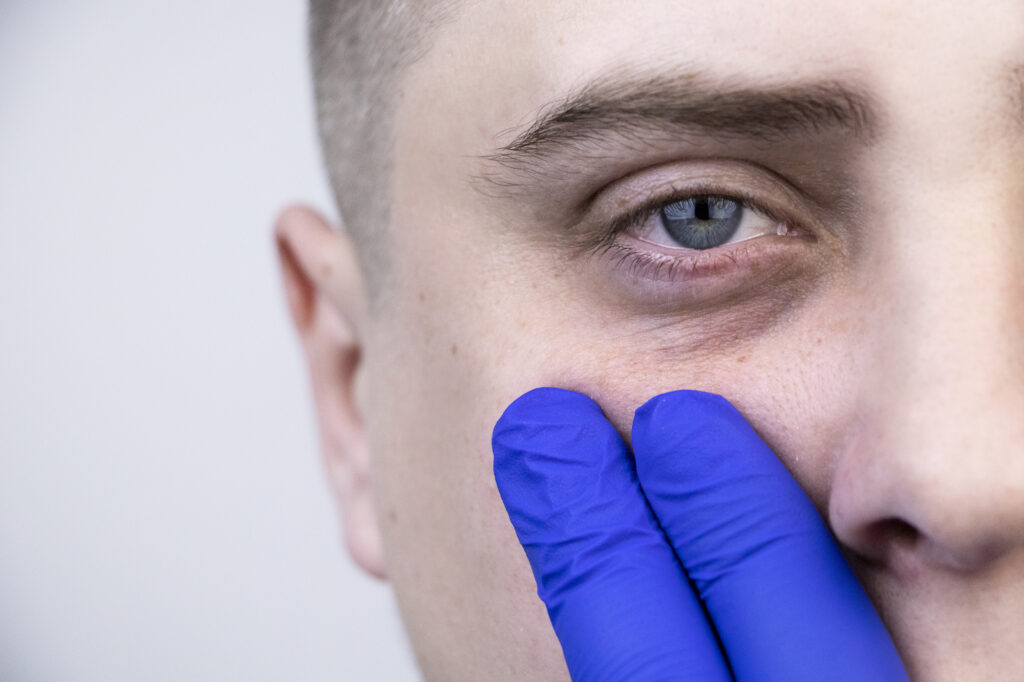Bags under the eyes are a common cosmetic concern. Nearly everyone experiences puffy eyes or saggy skin in the under-eye area. This is because the skin around your eyes is thinner and more delicate than anywhere on your body.
Some cases of under-eye bags require medical treatment. Other times, getting enough sleep is enough to reduce under-eye puffiness.
This article covers treatment options for under-eye bags. Options include eyelid surgery and at-home treatments. Talk to a dermatologist or plastic surgeon to determine the best treatment for you.
What Are Eye Bags?
Eye bags are dark, puffy circles under the eyes. They are also referred to as dark circles or dark shadows.

Some reasons why you might develop bags under your eyes include:
- Tiredness. Failure to get enough sleep may result in red, puffy, and droopy eyes.
- Allergic reactions. Allergy symptoms like congestion and inflammation cause puffiness under the eyes.
- High salt intake. Consuming too much salt may cause fluid retention. This can result in swelling under the eyes.
- Medical conditions. Some health conditions, like thyroid issues, can irritate your eyes and cause eye bags.
- Genetic predisposition. Some people inherit under-eye bags from family members.
- Natural aging process. As you age, your skin starts to lose firmness. When this happens, you may notice droopy skin under your eyes.
What Is Lower Eyelid Surgery?
Lower eyelid surgery, also called blepharoplasty, is a cosmetic procedure to reduce the appearance of eye bags. Lower lid blepharoplasty involves removing excess skin and fat from the under-eye area to reduce bags and wrinkles.
Some people also get upper eyelid blepharoplasty to achieve a more youthful appearance.
How Much Does Eye Bag Surgery Cost?
The average cost of cosmetic eyelid surgery is about $4,120.10
However, the cost of eye bag surgery depends on various factors:
- Location of the surgery
- Doctor
- Whether or not insurance will cover the surgery
Most insurance companies do not cover plastic surgery costs if the procedure is for cosmetic reasons. If your insurance does cover the surgery, make sure to find a surgeon in your network who accepts your coverage.
What to Expect from a Lower Eyelid Surgery Procedure
Lower eyelid surgery is a relatively quick, outpatient procedure. Here’s what to expect:
Before Surgery
During a consultation for lower eyelid surgery, you will discuss your health history with your doctor. They will evaluate your vision and eye care history. They cannot conduct the surgery if you’ve had refractive surgery (like LASIK or PRK) in the last 6 months.
Your doctor will assess the quality of your skin, the soft tissue, and the area’s skeletal support.
If there are other ways to treat your under-eye bags, your doctor will likely recommend those first. If your under-eye bags are the result of an allergic reaction, they may direct you to an allergy specialist.
During Surgery
You may receive general anesthesia before the surgical procedure. Otherwise, you will receive local anesthesia to numb the area around your eyes.
During lower eyelid surgery, the surgeon removes excess fat from under your eye. They may also tighten the muscles and skin to smooth the surface. In some cases, they may inject fat into hollow areas.
When they’re finished, they will use sutures to close the incisions and tighten the skin.
After Surgery
After the surgery is over, you will stay at your surgeon’s office for monitoring. You will be allowed to leave later that day.
Your doctor will likely advise you to do the following:
- Use a cold compress on your eyes for about 10 minutes every hour following surgery (over time, use the ice pack less)
- Clean your eyes gently with eye drops and ointments as prescribed
- Avoid straining or rubbing your eyes for a week
- Stay away from strenuous activities for a week
- Avoid smoking
- Don’t wear contacts for about 2 weeks following surgery
- Protect your eyes from the sun and wind with darkly tinted sunglasses
- Use cool compresses to reduce swelling
- Sleep with your head raised above your chest for the first few days following surgery
Follow your doctor’s instructions for after care. If you work, take about a week off after reconstructive surgery to allow your lower lid skin to heal.
Side Effects and Risks of Eye Bag Surgery
Lower eyelid surgery is generally safe. However, all surgical procedures involve side effects and risks.
Side Effects
Side effects of eye bag surgery include:
- Irritated eyes
- Watery eyes
- Blurred vision
- Light sensitivity
- Double vision
- Swelling
- Bruising
- Pain
- Discomfort
Potential Complications
Risks of eye bag surgery include:
- Scarring
- Injury to the eye muscles
- Infection
- Dry eyes
- Difficulty closing the eyes
- Blurred vision
- Loss of eyesight (very rare)
Home Remedies for Under-Eye Bags
There are several ways to treat eye bags without surgery. Here are some home remedies you can try:
Get Enough Sleep
If your eye bags are a result of sleep deprivation, make sure you’re getting enough rest. Most adults need 7 to 9 hours of sleep every night.
Cut Back on Salty Foods
If your sodium intake is too high, your body will retain water. This causes inflammation, including around the eyes.
The American Heart Association (AHA) recommends consuming no more than 2,300 milligrams of salt per day for most adults. Ideally, you shouldn’t consume more than 1,500 milligrams per day. This is especially true if you have high blood pressure.11
Use Eye Cream
Sagging skin creates the appearance of eye bags. There are various over-the-counter (OTC) products you can use to rejuvenate, hydrate, and tighten the skin.
Products like eye creams, masks, and peels can improve the appearance of fine lines and wrinkles.
Try a Cool Compress
Cold compresses reduce inflammation by constricting blood vessels around the eyes. You can use any of the following:
- Ice pack
- Frozen bag of vegetables
- Refrigerated spoons
- Cold green tea bags
Apply Makeup
Cosmetics like concealers and foundations are a great temporary solution for dark shadows under eyes.
Wash your face at night after removing makeup. Sleeping with makeup on can harm your skin and produce adverse effects like acne.
Take Collagen Supplements
Collagen is a protein in your body. It’s necessary for healthy skin, nails, hair, and joints. Collagen production naturally decreases with age, but taking supplements can help.
Collagen supplements come in the form of powders, capsules, and liquid.
Treat Allergies
If an allergic reaction is causing your eyes to swell, you may need medication. Talk to your doctor to find the best medicine or treatment for your allergies.
Alternative Treatments for Eye Bags
If at-home treatments don’t provide the results you’re looking for, consult a dermatologist or medical aesthetics professional for alternative treatments.
There are several options for treating eye bags without surgery, including:
Laser Resurfacing
A series of laser treatments can reduce the appearance of wrinkled skin under your eyes. Laser resurfacing works by stimulating cellular renewal for firmer skin. Results last for several years.4
Dermal Fillers
Fillers involve injecting a gel — usually hyaluronic acid — beneath the skin to create a smooth, youthful contour.
Dermal fillers aren’t U.S. Food and Drug Administration (FDA)-approved to treat under-eye bags, but some doctors use them as an off-label treatment.
In the U.S., more than a million people have fillers injected every year. Fillers can last anywhere from 6 to 18 months.7
Summary
While eye bags are not usually anything serious, many people treat them for cosmetic reasons. Fortunately, there are many ways to treat under eye bags at home and with the help from a doctor or skin specialist.
Surgery may not be an option or the best choice. Talk to your doctor about the best treatments for you.
In this article






